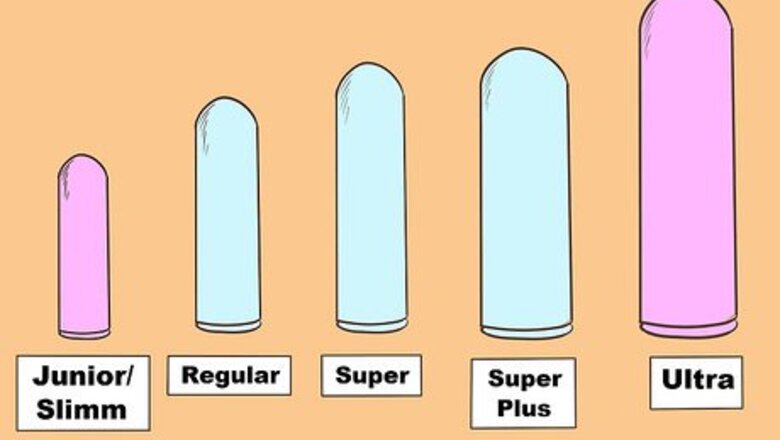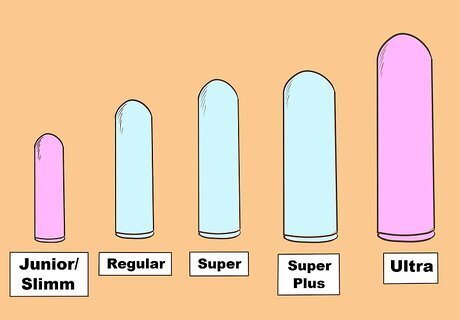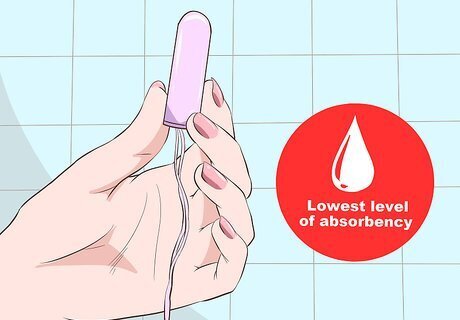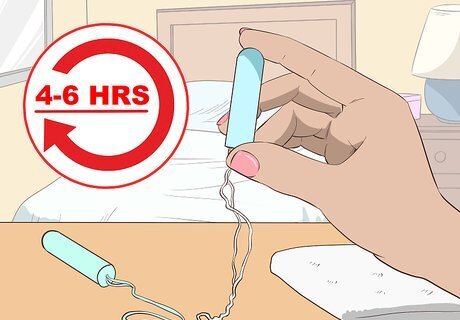
views
Choosing the Right Absorbency

Learn about absorbency options. Tampon sizes correspond the amount of liquid they can absorb. You can select the right absorbency level for you based on the level of your flow. The most common tampon absorbency levels (moving from smallest to largest) include: Regular Super Super Plus Some brands may also offer Junior/Slim (smaller than Regular) and/or Ultra (larger than Super Plus).

Choose the lowest level of absorbency needed to avoid TSS. Toxic Shock Syndrome (TSS) is a rare but serious condition that can result from using higher absorbency tampons. To prevent TSS, you should always use the lowest absorbency level to meet your needs. Start with Regular (or Junior/Slim) tampons, and move up to a higher absorbency level if needed. Symptoms of TSS include: high fever, low blood pressure, vomiting or diarrhea, and a rash that resembles a sunburn. You will know an absorbency level is meeting your needs if it is not saturated in 4-6 hours. If you need to change your tampon more frequently than every 4 hours, or if you are experiencing leaks, you may want to try a higher absorbency.

Use different absorbencies on different days. For most people, flow is the heaviest on days 1-3 of their cycle. After this, the flow usually begins tapering off (for days 3-7 or longer). You can use higher absorbency tampons on your heavy flow days, and switch to lower absorbency as your period begins to taper off. Look for tampons sold in variety packs, with multiple absorbency levels in one package. You may want to use a panty liner or pad as a back-up on heavy flow days.

Change your tampon every 4 hours. In order to prevent infections (such as TSS), it is important to remove your tampon every 4 hours, even if it is not completely full. If you have just started using tampons, it can be helpful to set a timer for yourself. Remember to use the lowest absorbency level to meet your needs.
Selecting Additional Features

Start with slender tampons. If you are new to using tampons, or if you find regular tampons too bulky, look for tampons that labeled Junior, Slim, or Slim fit. These tampons can be easier to insert, and can be more comfortable for some people. Junior/slim tampons may not be available in stores that have limited selections, such as grocery stores or gas stations. You can easily find these products at pharmacies, drug stores, or anywhere with a wide selection of feminine hygiene products.

Choose an applicator. An important factor when selecting the right tampon for you is choosing the right applicator. If you are new to using tampons, plastic applicator tampons can be the easiest to insert. But all applicator types have their benefits. Plastic applicator - These tend to be the easiest to insert (for most people). Extendable applicator - These are usually made of plastic and are designed to be more discreet. To use, you first pull down on the applicator to extend it. Cardboard applicator - These are the least expensive type of tampons, and are commonly found in vending machines. Digital tampon (applicator-free) - These tampons are inserted using your finger. Some people find these easier. They are also discreet and produce less waste.

Use “active” tampons for physical activity. If you workout, play sports, or live a very active lifestyle, you might try using “active” or “sport” tampons. These tampons are designed to be flexible and move with you. This is meant to avoid leaks. Any kind of tampon can be used while swimming or playing sports. Just find the size and style of tampon that works best for you.

Try different brands. Each brand of tampon is a little different, and even within each brand there are a wide range of different tampons. The specific shapes and fit will vary from brand to brand, and product to product. You may want to try several different kinds of tampons in order to find the product that works best for you. Some brands include: Tampax Playtex Kotex O.B. (applicator-free) Seventh Generation (organic cotton)

Avoid scented tampons. Tampons are available in both scented and unscented varieties. Avoid using scented (or deodorant) tampons! The chemical additives used can cause irritation. As long as you change your tampon every 4-6 hours, you should not experience any unpleasant odors. If you’d like to go a step further and avoid all chemical additives, you may want to choose organic cotton tampons.




















Comments
0 comment